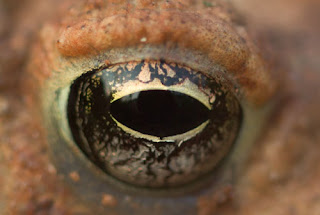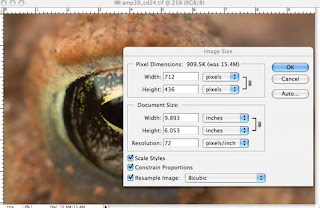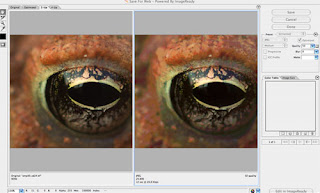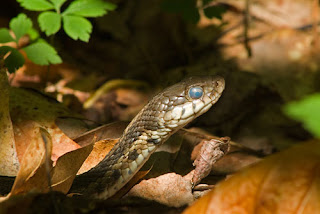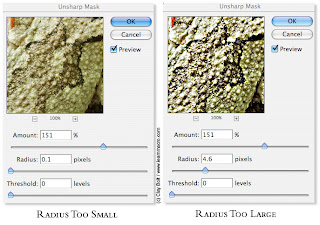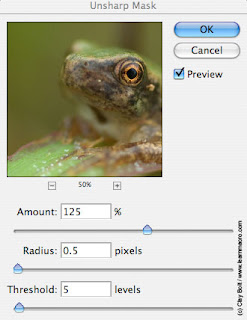 III. Critical Technical Skills for the Beginner–
III. Critical Technical Skills for the Beginner–1.) Understanding Depth-of-Field and Shutter-Speed:
Depth-of-field revolves refers to the sharply and softly focused parts of an image. If an image is mostly soft with only a small section –say an animal’s eyes or the edge of flower’s petal– in sharp focus then you could say that it has a shallow depth-of-field. However, if the image–let’s imagine that it is a landscape, for example– has a sharp background, sharp middle ground, and a sharp image in the foreground then it has a great depth-of-field. In John Shaw’s “Nature Photography Field Guide” (see 'great books' on right side bar) he outlines the four factors which determine the area of sharpness.
“1.) The actual f-stop at which the picture is taken. 2.) The focal length of the lens being used 3.) The size of the subject being photographed and 4.) The distance between the camera and the subject.”
If you examine your S.L.R. lens you will notice a series of f-stops which go around its barrel. This series of markings represent the size of the aperture –or opening– of the iris of the lens. This is determined by whatever f-stop is chosen by the user. This series of numbers typically run from f/2.8, f/4, f/5.6, f/8, f/11, f/16, f/22 and f/32.
Consider the following thoughts:
- The smaller the f-stop number (f/2.8, for ex); the larger the aperture; the shallower the depth-of-field; the more light that comes into the camera.
- The larger the f-stop number (f/32, for ex.); The smaller the aperture; the greater the depth-of-field; the less light that goes into the camera.
This really confused me when I first began learning how to operate a pro camera until I realized the that numbers represented fractions, i.e.: f/2.8 divided by 2 = @ f/4 , f/4 divided by 2 = @ f/5.6 and so on.
Shutter-Speeds control how fast the camera’s shutter opens and closes. This effects the amount of light that comes into the camera and also can determine whether or not an image is in sharp or in soft-focus. Shutter speeds are also listed in fractions (of a second). So, a shutter speed of 1 second is going to keep the aperture open longer than, say, one at 1/1000 of second. If you are wanting to capture a sharp image of a moving subject you must typically set your aperture at 1/125 of a second or less.
There are two approaches that you will most likely have to choose between when composing an image: aperture priority or shutter priority. A good example of a typical aperture priority image might be a “classic Ansel Adams” type of landscape. This is a situation in which you want every rock, tree and tumble weed from where you stand, to the distant horizon, to be in sharp focus. In order for this to occur you are going to want “stop-down” to your smallest aperture (f/22 - f/32 in most cases). Because this is a very small aperture very little light will be entering the camera which can affect the exposure time. So, you must compensate for this by choosing a much slower shutter speed in order to allow the needed light to enter the camera.
A shutter priority image is one where you want to freeze some sort of movement. It might be that you are photographing a sports event and want to make sure that the ball is frozen in mid-air or perhaps you are trying to capture a crystal clear image of a salmon leaping its way up some Alaskan river; either of these would be shutter priority images.
2.) Paralleling the Subject:
When you are creating a close-up photograph of a small subject camera position can have an incredible impact of the results that you get. Because depth-of-field is usually very limited when a subject is being photographed at 1:1 or greater, a movement of just an inch can drastically alter the composition. The photographer must identify the ‘important’ part of the subject that he/she would like to have in sharp focus and attempt to keep the back of the camera (or film plane/digital sensor) as parallel with the subject as possible. This process is very time consuming but can be made easier by using a sturdy tripod to hold the position of the camera.
IV. Composition Techniques–
1.) The Rule of Thirds:
This is one of the most widely used ‘rules’ in photography: Mentally divide the image the image frame into three equal pieces horizontally/vertically and place your subject into one of these spaces. This will help you to avoid placing the image in the center (which is generally not a good ideas but as with most rules, there are exceptions). This will put you on the right path towards creating an image that is interesting and visually pleasing.
2.) Horizontal or Vertical?:
Consider your subject before defaulting to a “horizontal” or “vertical” composition. Although we Westerners tend to scan information from left to right and find a horizontal composition to be a natural choice this isn’t always the best choice. Some images simply call for a vertical composition.
3.) Understanding the Relationship Between Positive and Negative Space:
It is human nature to just focus on the subject when making an image. However, the negative space –or space surrounding your subject– is often as powerful as the main focus area when it comes to affecting how an image appears. If used correctly, negative space can give the viewer’s eye a chance to rest and serves to guide the eye throughout a composition. In order to take an image to the ‘next level’ every aspect of the composition becomes a factor in determining the final outcome.
4.) Pay Attention to Backgrounds:
I cannot tell you how many times I’ve taken what I consider to be a great image only to revisit it later and notice a twig that appears to pierce my subject’s head. Often, only a minor adjustment in camera position is needed to make a mediocre image into a truly great one. Pay attention to what is behind your subject! Use aperture to control how much or how little of the background is in focus; little things done well add up to make a successful photograph!
 This past weekend, we had unseasonably warm weather for December in South Carolina and I was hit –unseasonably, as well– with a touch of spring fever. I went out on Friday night and walked along the banks of our creek hoping to find a salamander out and about or some other animal revived by the warming trend. I managed to, in fact, spot a salamander in the creek– just barely, before it slipped under the bank–and a lone water boatman lazily dipping, diving and twirling about in a small pool. Other than that, a few raccoon tracks were all that materialized. In the morning, I was amazed to hear a few stray spring peepers getting an early start on their yearly ritual. I quickly ran out into the foggy morning hoping that I could find just one of the tiny amphibians to photograph before winter came back from lunch. My search ended in vain, and I was stuck with the silence that was only broken occassionally by the death rattle of beech leaves, which still clung tightly to slender branches. However, it wasn't long before I became charmed by the forms of the stripped down trees and mist shrouded landscape all around me. If winter is a metaphor for life here in the temperate zone, it most certainly represents our world's need for rest and reflection. In my own life, I find it very difficult to relax at times because I am constantly thinking about my next move and have already begun plotting out what I'll be up to when spring returns next year. Photography in the winter months, here in South Carolina, is very challenging to me because the deciduous areas of the state become stuck in a sort of visual no man's land; between the faded colors of autumn and the verdancy of spring not yet realized. We don't have the cleansing snows of the north and the simplicity of a desert winter. Instead, we are often left with a jumble of denuded forms screaming for attention all at once. It will serve me well to be patient in the understanding that spring will return again soon.
This past weekend, we had unseasonably warm weather for December in South Carolina and I was hit –unseasonably, as well– with a touch of spring fever. I went out on Friday night and walked along the banks of our creek hoping to find a salamander out and about or some other animal revived by the warming trend. I managed to, in fact, spot a salamander in the creek– just barely, before it slipped under the bank–and a lone water boatman lazily dipping, diving and twirling about in a small pool. Other than that, a few raccoon tracks were all that materialized. In the morning, I was amazed to hear a few stray spring peepers getting an early start on their yearly ritual. I quickly ran out into the foggy morning hoping that I could find just one of the tiny amphibians to photograph before winter came back from lunch. My search ended in vain, and I was stuck with the silence that was only broken occassionally by the death rattle of beech leaves, which still clung tightly to slender branches. However, it wasn't long before I became charmed by the forms of the stripped down trees and mist shrouded landscape all around me. If winter is a metaphor for life here in the temperate zone, it most certainly represents our world's need for rest and reflection. In my own life, I find it very difficult to relax at times because I am constantly thinking about my next move and have already begun plotting out what I'll be up to when spring returns next year. Photography in the winter months, here in South Carolina, is very challenging to me because the deciduous areas of the state become stuck in a sort of visual no man's land; between the faded colors of autumn and the verdancy of spring not yet realized. We don't have the cleansing snows of the north and the simplicity of a desert winter. Instead, we are often left with a jumble of denuded forms screaming for attention all at once. It will serve me well to be patient in the understanding that spring will return again soon.

